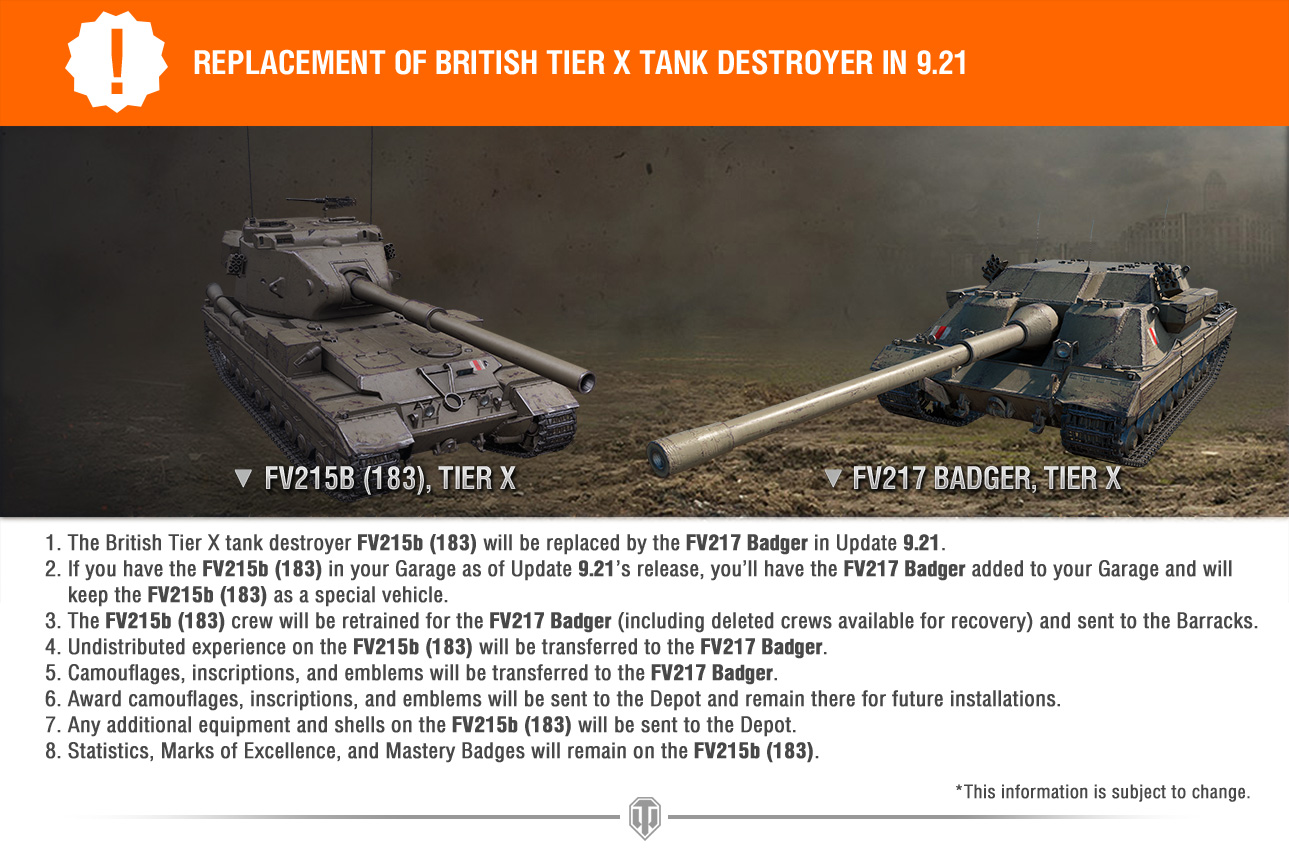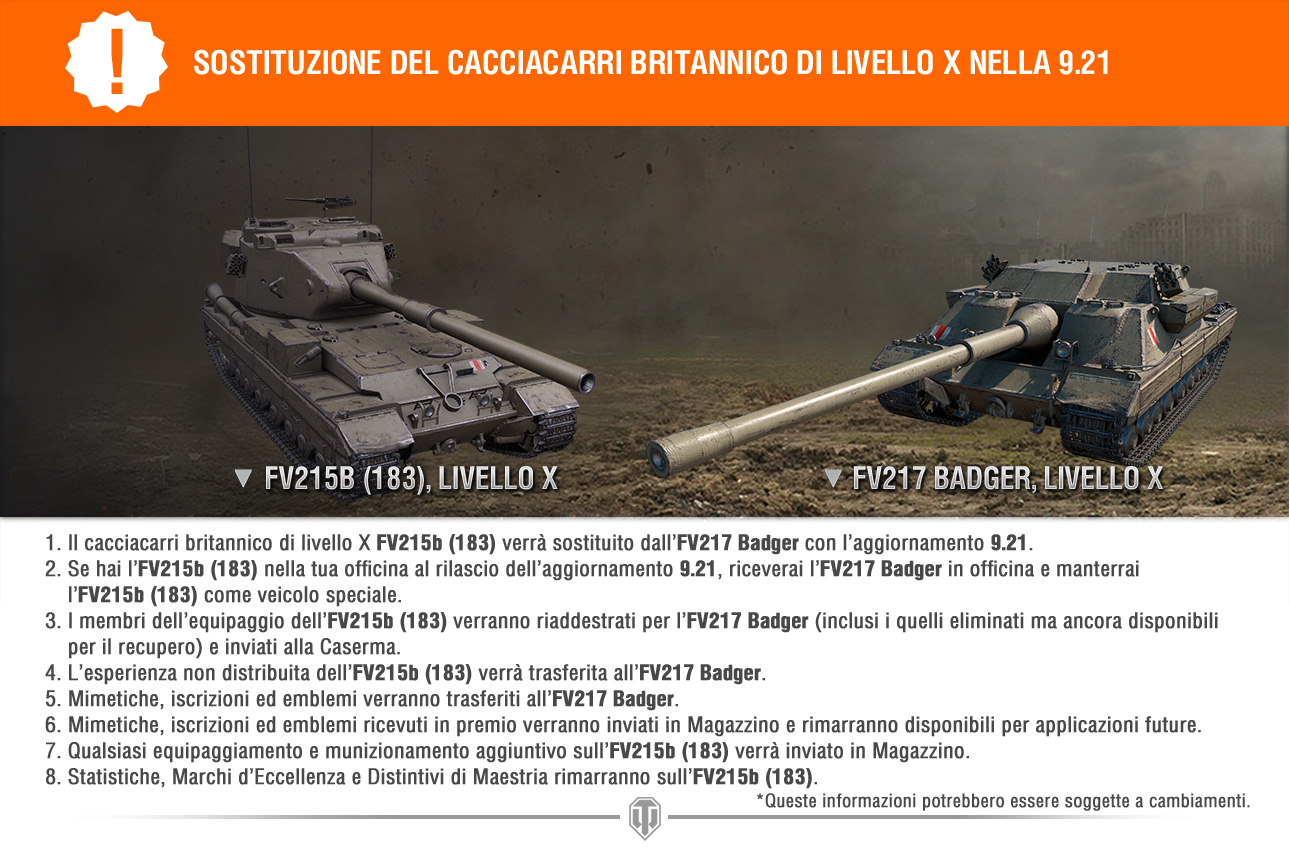Source: EU WoT Portal
British non-turreted TDs are largely underappreciated due to their feeble armor. We address this long-standing issue as part of an all-around Tech Tree revision, increasing their protection to help them reclaim a place among conventional assault TDs. With thicker protection up front and on the sides, they no longer suffer from glaring armor weaknesses and can be an intimidating force leading the attack or helping allies. With that, let’s dive into the details!
Why Revise Them?
TDs on the FV215b (183) line won’t exactly set the Thames on fire (er, not that you’d want to) when it comes to mobility, but it’s not their job to win races. These Brits pick their battles and have enough damage potential to put heavily-armored enemies to sleep working as assault guns or supporting the team from the frontline. Thick armor, excellent DPM (over 2,000 at Tier V; sweet, huh?), a great fire rate, and easy gun handling let them meticulously destroy the opposition, compensating for below-average mobility.
However, this otherwise great picture is spoiled by chinks in their (figurative) armor. Though their (literal) armor seems solid on paper, we all know listed values don’t tell the whole story. If you took them for a stroll, you must have noticed they’re riddled with weakspots—the commander’s cupola. And once you’re spotted, you become target number one. Enemies don’t even have to go the extra mile to send you to the scrap heap; just shoot the “head,” and away you go. As a result, playing it safe works best for these TDs, which contradicts their “close-range assault guns” narrative. Update 9.21 should set them back on the right course.
What’s Changing?
The AT 2 was quite formidable thanks to its armor. Opponents below Tier VII could hardly get a scratch on it. We took some of the AT 2’s frontal, side and rear armor to keep it from being OP. It’s now far less bouncy from the front. However, it’s not all bad news for those who fancy this Brit: changes to side plates should give it an edge at sidescraping.
The large thinly-armored section on the right side of the AT 8 made it extremely easy to cripple, even for low-tier opponents. Add to that three barely protected cupolas on its top, and there you have it—a soft target living on borrowed time. Update 9.21 boosted its efficiency by eradicating the massive weak spot to the right. Cupolas received better protection, too.
The AT 7 and AT 15 had little hope of soaking up damage from the front or when their gun mantlets and cupolas were targeted. We increased armor thickness for these weak spots to gear up there two for a more active role in close-quarters fights.
Feeble frontal armor and a thin gun mantlet made the Tortoise a soft target for Tier IX and X tanks. Update 9.21 improves both and gives the vehicles a thicker superstructure roof. It retains a vulnerable main gun cupola though, with a glaring weak spot at its center.
The Churchill Gun Carrier was underappreciated because of its low alpha and unimpressive-for-its-tier penetration, often leaving players thoroughly underwhelmed in the heat of battle. After feedback, we went through the 32-pounder parameters. Alpha damage and pen went up, while DPM stayed as is. This Brit literally exists to carry a gun, and now it can carry it proudly! The AT 15 and Tortoise that equip the same 32-pounder benefit from greater pen stats and alpha strike, too.
Why Replace the “Death Star?”
This revision won’t be complete without a rewarding experience at Tier X. With the entire line redesigned for close-range assault and support, we wanted the top tier to incorporate all the line’s distinctive traits. This way, you can figure out whether it’s worth the grind soon after you start the line.
No one would argue that a FV215b (183) staring at you is just about the worst thing any tanker can see on the battlefield. It’s universally feared for its gun, capable of one-shotting most Tier IX and X tanks. However, its alpha damage comes at the cost of low speed, a long reload, limited accuracy and sub-par ammo count, which is nowhere close to the line’s overall narrative. This is where the all-new FV217 Badger steps in, forcing the FV215b (183) to retreat as a special vehicle. Unlike the Death Star, it inherits a combination of decent armor, solid DPM, and excellent rate of fire from its brethren down line, but gets more of these in every department. Capable of dealing a whopping 4500 DPM, the Badger won’t fail to put a round downrange with true British composure. Then, it’ll move on to rain devastation on the next unlucky tanker…
How Will It All Work?
The FV217 Badger might be yours for the taking, no grind required, if you have the FV215b (183) researched and purchased when 9.21 releases. Read the transition details and look forward to a detailed overview!

We’re looking forward to your thoughts and questions on the latest balance changes. Take the revised TDs for a drive during Common Test and please join the discussion over on the forum.
I cacciacarri britannici senza torretta sono poco apprezzati, a causa della loro debole corazzatura. Abbiamo affrontato questo problema di lunga data all’interno di una più complessiva revisione dell’albero tecnologico. Abbiamo deciso di aumentare la loro protezione, al fine di restituirgli il posto che gli spetta fra i cacciacarri d’assalto convenzionali. Grazie alla superiore corazzatura frontale e laterale, ora non avranno più debolezze evidenti e potranno tornare ad essere una temibile forza di sfondamento o di supporto agli alleati. Detto ciò, entriamo ora nei dettagli!
Perché modificarli?
I cacciacarri della linea dell’FV215b (183) non sono proprio il massimo in termini di mobilità, ma il loro scopo non è vincere una gara di velocità. Questi britannici hanno sufficiente potenza di fuoco per mettere a tacere nemici pesantemente corazzati, lavorando come cannoni d’assalto oppure supportando la squadra alleata lungo la linea del fronte. Corazzatura spessa, eccellente danno per minuto (oltre 2.000 a livello V, non male eh?), elevato rateo di fuoco e ottima maneggevolezza del cannone, consentono loro di distruggere meticolosamente ogni avversario. Tutto ciò al prezzo di una ridotta mobilità.
Tuttavia, questo grandioso quadro generale è rovinato da alcuni evidenti difetti. La loro corazzatura è fantastica sulla carta, ma noi tutti sappiamo che la realtà è ben diversa. Se avete mai giocato con questi veicoli, avrete sicuramente notato il loro punto debole: la cupola del comandante. E una volta che vengono avvistati, diventano il bersaglio prioritario. I nemici non devono faticare molto per trasformare questi cacciacarri in carcasse fumanti: è sufficiente sparare “alla testa”, ed ecco fatto. Perciò il miglior stile di gioco per questi mezzi è molto conservativo. Con una bella differenza rispetto a quanto ci si aspetterebbe da loro in quanto “cannoni d’assalto”. L’aggiornamento 9.21 dovrebbe riportarli sulla retta via.
Cosa cambierà?
L’AT 2 era formidabile, grazie alla sua corazzatura. Gli avversari di livello inferiore a VII difficilmente erano in grado di danneggiarlo. Perciò abbiamo ridotto gli spessori sul frontale, sui lati e sul retro. Ora il frontale è più facile da penetrare. Tuttavia, non ci sono solo brutte notizie per gli amanti di questo britannico: i cambiamenti apportati alla corazzatura dovrebbero garantire un vantaggio in situazione di sidescraping.
L’ampia e sottile sezione laterale destra dell’AT 8 lo rende facile da penetrare, anche da avversari di livello inferiore. Aggiungi tre cupole praticamente prive di protezione ed ecco servito un bersaglio pronto per la distruzione. L’aggiornamento 9.21 ne ha migliorato l’efficienza rimuovendo l’enorme punto debole sulla destra e aumentando la resistenza delle cupole.
L’AT 7 e l’AT 15 avevano poche possibilità di bloccare danni frontali o quando il mantelletto e le cupole venivano presi di mira. Abbiamo aumentato lo spessore della corazza di suddetti punti deboli per rendere questi carri più efficienti nei combattimenti a distanze ravvicinate.
La flebile corazza frontale e il sottile mantelletto del cannone hanno reso il Tortoise un fragile bersaglio per veicoli di livello IX e X. L’aggiornamento 9.21 li fortifica entrambi e dona al veicolo una sovrastruttura rinforzata sul tetto. Mantiene tuttavia la vulnerabilità della cupola frontale, con un evidente punto debole al centro.
Il Churchill Gun Carrier non veniva apprezzato a causa dei bassi danni per colpo e della deludente penetrazione, facendo spesso ritrovare i giocatori impotenti nel mezzo della battaglia. Dopo vari feedback, abbiamo rielaborato i parametri del 32-pounder. I danni per colpo e la penetrazione sono aumentati mentre i DPM sono rimasti invariati. Questo britannico è stato progettato appositamente per trasportare un cannone e adesso ha la possibilità di trasportarlo con onore! Anche l’AT 15 e il Tortoise che montano lo stesso 32-pounder otterranno i benefici dalla penetrazione e dai danni per colpo aumentati.
Perché sostituire la “Morte Nera”?
Questa revisione non sarebbe completa senza una esperienza gratificante a livello X. Con l’intera linea riprogettata per l’assalto a breve distanza e il supporto, volevamo che il veicolo di livello massimo incorporasse i tratti distintivi di tutta la linea. In questo modo, sarà possibile capire se la linea è vale lo sforzo per completarla da poco dopo il suo inizio.
Nessuno obietta che vedersi davanti un FV215b (183) che ti punta sia l’incubo peggiore di qualsiasi carrista. Il suo cannone è temuto da tutti perché in grado di distruggere la maggior parte dei livelli IX e X con un solo colpo. Tuttavia, il suo impressionante danno per colpo singolo è compensato dalla bassa velocità, lungo tempo di ricarica, precisione limitata e quantità di proiettili scarsa, caratteristiche molto lontane da quelle del resto della linea. Ecco il punto in cui fa il suo ingresso il nuovo FV217 Badger, obbligando l’FV215b (183) a ritirarsi come veicolo speciale. A differenza della Morte Nera, eredita una combinazione di corazza discreta, danno per minuto consistente ed eccellente cadenza di fuoco, direttamente dai suoi predecessori, ma con miglioramenti sotto ogni aspetto. È in grado di infliggere fino a 4500 danni al minuto; il Badger non fallirà nel mettere a segno un colpo con vera compostezza inglese e, dopo aver fatto il suo dovere, si sposterà per portare devastazione sul prossimo carrista sfortunato…
Come avverrà tutto ciò?
L’FV217 Badger si potrà avere senza alcuno sforzo, ma solo se si ha l’FV215b (183) ricercato e acquistato al rilascio della 9.21. Leggete i dettagli del passaggio prima dell’arrivo di una panoramica dettagliata!

Attendiamo i vostri pareri e le vostre domande sugli ultimi cambiamenti per il bilanciamento. Fate un giro con i cacciacarri revisionati durante il Common Test e partecipate alla discussione sul forum.
